A Meta-Analysis of the Impact of Using Angiotensin-Converting Enzyme Inhibitors (ACEIs) or Angiotensin II Receptor Blockers (ARBs) on Mortality, Severity, and Healthcare Resource Utilization in Patients with COVID-19
Abstract
:Highlights
- The use of ACEIs and ARBs presents both advantages and disadvantages for patients with COVID-19.
- The utilization of ACEIs and ARBs does not demonstrate a substantial correlation with mortality, severity, or healthcare resource utilization in patients with COVID-19.
- The utilization of ACEIs and ARBs in patients diagnosed with COVID-19 is associated with benefits that outweigh the potential drawbacks.
- The utilization of ACEIs and ARBs has been shown to be safe medical practice.
Abstract
1. Introduction
2. Materials and Methods
2.1. Search Strategy
2.2. Inclusions and Exclusions Criteria
2.3. Literature Quality Assessment
2.4. Data Extraction
2.5. Statistical Analysis
2.6. Publication Bias of Assessment
2.7. Sensitivity Analysis
2.8. Statement
3. Results
3.1. Articles Search Results
3.2. Basic Characteristics of the Included Studies
3.3. Quality Evaluation of the Included Literature
3.4. Meta-Analysis Outcomes
3.5. Meta-Regression Outcomes
3.6. Publication Bias
3.7. Sensitivity Results
4. Discussion
5. Conclusions
Author Contributions
Funding
Institutional Review Board Statement
Informed Consent Statement
Data Availability Statement
Conflicts of Interest
References
- de Oliveira, P.G.; Termini, L.; Durigon, E.L.; Lepique, A.P.; Sposito, A.C.; Boccardo, E. Diacerein: A potential multi-target therapeutic drug for COVID-19. Med. Hypotheses 2020, 144, 109920. [Google Scholar] [CrossRef] [PubMed]
- Degnah, A.A.; Al-Amri, S.S.; Hassan, A.M.; Almasoud, A.S.; Mousa, M.; Almahboub, S.A.; Alhabbab, R.Y.; Mirza, A.A.; Hindawi, S.I.; Alharbi, N.K.; et al. Seroprevalence of MERS-CoV in healthy adults in western Saudi Arabia, 2011–2016. J. Infect. Public Health 2020, 13, 697–703. [Google Scholar] [CrossRef] [PubMed]
- WHO Rapid Evidence Appraisal for COVID-19 Therapies (REACT) Working Group; Sterne, J.A.C.; Murthy, S.; Diaz, J.V.; Slutsky, A.S.; Villar, J.; Angus, D.C.; Annane, D.; Azevedo, L.C.P.; Berwanger, O.; et al. Association Between Administration of Systemic Corticosteroids and Mortality Among Critically Ill Patients with COVID-19: A Meta-analysis. JAMA 2020, 324, 1330–1341. [Google Scholar]
- Singh, A.; Gupta, V. SARS-CoV-2 therapeutics: How far do we stand from a remedy? Pharmacol. Rep. 2021, 73, 750–768. [Google Scholar] [CrossRef] [PubMed]
- WHO Coronavirus (COVID-19) Dashboard|WHO Coronavirus (COVID-19) Dashboard with Vaccination Data. Available online: https://covid19.who.int/ (accessed on 24 November 2024).
- Xu, Y.; Rong, J.; Zhang, Z. The emerging role of angiotensinogen in cardiovascular diseases. J. Cell. Physiol. 2021, 236, 68–78. [Google Scholar] [CrossRef]
- Pang, X.; Cui, Y.; Zhu, Y. Recombinant human ACE2: Potential therapeutics of SARS-CoV-2 infection and its complication. Acta Pharmacol. Sin. 2020, 41, 1255–1257. [Google Scholar] [CrossRef]
- Medina, D.; Arnold, A.C. Angiotensin-(1-7): Translational Avenues in Cardiovascular Control. Am. J. Hypertens. 2019, 32, 1133–1142. [Google Scholar] [CrossRef] [PubMed]
- Hikmet, F.; Méar, L.; Edvinsson, Å.; Micke, P.; Uhlén, M.; Lindskog, C. The protein expression profile of ACE2 in human tissues. Mol. Syst. Biol. 2020, 16, e9610. [Google Scholar] [CrossRef]
- Singh, M.; Bansal, V.; Feschotte, C. A single-cell RNA expression map of human coronavirus entry factors. Cell Rep. 2020, 32, 108175. [Google Scholar] [CrossRef] [PubMed]
- Labandeira-Garcia, J.L.; Labandeira, C.M.; Valenzuela, R.; Pedrosa, M.A.; Quijano, A.; Rodriguez-Perez, A.I. Drugs Modulating Renin-Angiotensin System in COVID-19 Treatment. Biomedicines 2022, 10, 502. [Google Scholar] [CrossRef]
- Guan, W.J.; Liang, W.H.; Zhao, Y.; Liang, H.R.; Chen, Z.S.; Li, Y.M.; Liu, X.Q.; Chen, R.C.; Tang, C.L.; Wang, T.; et al. Comorbidity and its impact on 1590 patients with COVID-19 in China: A nationwide analysis. Eur. Respir. J. 2020, 55, 2000547. [Google Scholar] [CrossRef]
- Wang, D.; Hu, B.; Hu, C.; Zhu, F.; Liu, X.; Zhang, J.; Wang, B.; Xiang, H.; Cheng, Z.; Xiong, Y.; et al. Clinical Characteristics of 138 Hospitalized Patients with 2019 Novel Coronavirus-Infected Pneumonia in Wuhan, China. JAMA 2020, 323, 1061–1069. [Google Scholar] [CrossRef]
- Huang, Y.; Yang, C.; Xu, X.F.; Xu, W.; Liu, S.W. Structural and functional properties of SARS-CoV-2 spike protein: Potential antivirus drug development for COVID-19. Acta Pharmacol. Sin. 2020, 41, 1141–1149. [Google Scholar] [CrossRef] [PubMed]
- Tipnis, S.R.; Hooper, N.M.; Hyde, R.; Karran, E.; Christie, G.; Turner, A.J. A human homolog of angiotensin-converting enzyme. Cloning and functional expression as a captopril-insensitive carboxypeptidase. J. Biol. Chem. 2000, 275, 33238–33243. [Google Scholar] [CrossRef]
- Walls, A.C.; Park, Y.J.; Tortorici, M.A.; Wall, A.; McGuire, A.T.; Veesler, D. Structure, Function, and Antigenicity of the SARS-CoV-2 Spike Glycoprotein. Cell 2020, 181, 281–292. [Google Scholar] [CrossRef]
- Yan, R.; Zhang, Y.; Li, Y.; Xia, L.; Guo, Y.; Zhou, Q. Structural basis for the recognition of SARS-CoV-2 by full-length human ACE2. Science 2020, 367, 1444–1448. [Google Scholar] [CrossRef]
- Luo, D.; Wan, X.; Liu, J.; Tong, T. Optimally estimating the sample mean from the sample size, median, mid-range, and/or mid-quartile range. Stat. Methods Med. Res. 2018, 27, 1785–1805. [Google Scholar] [CrossRef] [PubMed]
- Wan, X.; Wang, W.; Liu, J.; Tong, T. Estimating the sample mean and standard deviation from the sample size, median, range and/or interquartile range. BMC Med. Res. Methodol. 2014, 14, 135. [Google Scholar] [CrossRef] [PubMed]
- Bauer, A.; Schreinlechner, M.; Sappler, N.; Dolejsi, T.; Tilg, H.; Aulinger, B.A.; Weiss, G.; Bellmann-Weiler, R.; Adolf, C.; Wolf, D.; et al. Discontinuation versus continuation of renin-angiotensin-system inhibitors in COVID-19 (ACEI-COVID): A prospective, parallel group, randomised, controlled, open-label trial. Lancet Respir. Med. 2021, 9, 863–872. [Google Scholar] [CrossRef] [PubMed]
- Bae, D.J.; Tehrani, D.M.; Rabadia, S.V.; Frost, M.; Parikh, R.V.; Calfon-Press, M.; Aksoy, O.; Umar, S.; Ardehali, R.; Rabbani, A.; et al. Angiotensin Converting Enzyme Inhibitor and Angiotensin II Receptor Blocker Use Among Outpatients Diagnosed with COVID-19. Am. J. Cardiol. 2020, 132, 150–157. [Google Scholar] [CrossRef] [PubMed]
- Bean, D.M.; Kraljevic, Z.; Searle, T.; Bendayan, R.; Kevin, O.; Pickles, A.; Folarin, A.; Roguski, L.; Noor, K.; Shek, A.; et al. Angiotensin-converting enzyme inhibitors and angiotensin II receptor blockers are not associated with severe COVID-19 infection in a multi-site UK acute hospital trust. Eur. J. Heart Fail. 2020, 22, 967–974. [Google Scholar] [CrossRef]
- Cetinkal, G.; Kocas, B.B.; Ser, O.S.; Kilci, H.; Yildiz, S.S.; Celebi, S.N.; Verdi, Y.; Altinay, M.; Kilickesmez, K. The Association Between Chronic Use of Renin–Angiotensin-Aldosterone System Blockers and in-Hospital Adverse Events among COVID-19 Patients with Hypertension. Med. Bull. Sisli Etfal Hosp. 2020, 54, 399–404. [Google Scholar] [CrossRef] [PubMed]
- Chaudhri, I.; Koraishy, F.M.; Bolotova, O.; Yoo, J.; Marcos, L.A.; Taub, E.; Sahib, H.; Bloom, M.; Ahmad, S.; Skopicki, H.; et al. Outcomes Associated with the Use of Renin-Angiotensin-Aldosterone System Blockade in Hospitalized Patients with SARS-CoV-2 Infection. Kidney360 2020, 1, 801–809. [Google Scholar] [CrossRef]
- Choi, H.K.; Koo, H.; Seok, H.; Jeon, J.H.; Choi, W.S.; Kim, D.J.; Park, D.W.; Han, E. ARB/ACEI use and severe COVID-19: A nationwide case-control study. medRxiv 2020. [Google Scholar] [CrossRef]
- Cohen, J.B.; Hanff, T.C.; William, P.; Sweitzer, N.; Rosado-Santander, N.R.; Medina, C.; Rodriguez-Mori, J.E.; Renna, N.; Chang, T.I.; Corrales-Medina, V.; et al. Continuation versus discontinuation of renin-angiotensin system inhibitors in patients admitted to hospital with COVID-19: A prospective, randomised, open-label trial. Lancet Respir. Med. 2021, 9, 275–284. [Google Scholar] [CrossRef]
- Covino, M.; De Matteis, G.; Burzo, M.L.; Santoro, M.; Fuorlo, M.; Sabia, L.; Sandroni, C.; Gasbarrini, A.; Franceschi, F.; Gambassi, G.; et al. Angiotensin-converting enzyme inhibitors or angiotensin II receptor blockers and prognosis of hypertensive patients hospitalised with COVID-19. Intern. Med. J. 2020, 50, 1483–1491. [Google Scholar] [CrossRef]
- Cugno, M.; Gualtierotti, R.; Casazza, G.; Tafuri, F.; Ghigliazza, G.; Torri, A.; Costantino, G.; Montano, N.; Peyvandi, F. Mortality in Patients with COVID-19 on Renin Angiotensin System Inhibitor Long-Term Treatment: An Observational Study Showing that Things Are Not Always as They Seem. Adv. Ther. 2021, 38, 2709–2716. [Google Scholar] [CrossRef] [PubMed]
- Duarte, M.; Pelorosso, F.; Nicolosi, L.N.; Salgado, M.V.; Vetulli, H.; Aquieri, A.; Azzato, F.; Castro, M.; Coyle, J.; Davolos, I.; et al. Telmisartan for treatment of Covid-19 patients: An open multicenter randomized clinical trial. eClinicalMedicine 2021, 37, 100962. [Google Scholar] [CrossRef]
- Felice, C.; Nardin, C.; Di Tanna, G.L.; Grossi, U.; Bernardi, E.; Scaldaferri, L.; Romagnoli, M.; Tonon, L.; Cavasin, P.; Novello, S.; et al. Use of RAAS Inhibitors and Risk of Clinical Deterioration in COVID-19: Results From an Italian Cohort of 133 Hypertensives. Am. J. Hypertens. 2020, 33, 944–948. [Google Scholar] [CrossRef]
- Fosbøl, E.L.; Butt, J.H.; Østergaard, L.; Andersson, C.; Selmer, C.; Kragholm, K.; Schou, M.; Phelps, M.; Gislason, G.H.; Gerds, T.A.; et al. Association of Angiotensin-Converting Enzyme Inhibitor or Angiotensin Receptor Blocker Use with COVID-19 Diagnosis and Mortality. JAMA 2020, 324, 168–177. [Google Scholar] [CrossRef]
- Genet, B.; Vidal, J.-S.; Cohen, A.; Boully, C.; Beunardeau, M.; Harlé, L.M.; Gonçalves, A.; Boudali, Y.; Hernandorena, I.; Bailly, H.; et al. COVID-19 In-Hospital Mortality and Use of Renin-Angiotensin System Blockers in Geriatrics Patients. J. Am. Med. Dir. Assoc. 2020, 21, 1539–1545. [Google Scholar] [CrossRef]
- Hakeam, H.A.; Alsemari, M.; Al Duhailib, Z.; Ghonem, L.; Alharbi, S.A.; Almutairy, E.; Bin Sheraim, N.M.; Alsalhi, M.; Alhijji, A.; AlQahtani, S.; et al. Association of Angiotensin-Converting Enzyme Inhibitors and Angiotensin II Blockers with Severity of COVID-19: A Multicenter, Prospective Study. J. Cardiovasc. Pharmacol. Ther. 2021, 26, 244–252. [Google Scholar] [CrossRef] [PubMed]
- Huang, Z.; Cao, J.; Yao, Y.; Jin, X.; Luo, Z.; Xue, Y.; Zhu, C.; Song, Y.; Wang, Y.; Zou, Y.; et al. The effect of RAS blockers on the clinical characteristics of COVID-19 patients with hypertension. Ann. Transl. Med. 2020, 8, 430. [Google Scholar] [CrossRef] [PubMed]
- Kim, J.H.; Baek, Y.-H.; Lee, H.; Choe, Y.J.; Shin, H.J.; Shin, J.-Y. Clinical outcomes of COVID-19 following the use of angiotensin-converting enzyme inhibitors or angiotensin-receptor blockers among patients with hypertension in Korea: A nationwide study. Epidemiol. Health 2021, 43, e2021004. [Google Scholar] [CrossRef]
- Kuzeytemiz, M.; Tenekecioglu, E. Effect of renin-angiotensin system blocker on COVID-19 in young patients with hypertension. J. Investig. Med. 2022, 70, 786–791. [Google Scholar] [CrossRef]
- Lafaurie, M.; Martin-Blondel, G.; Delobel, P.; Charpentier, S.; Sommet, A.; Moulis, G. Outcome of patients hospitalized for COVID-19 and exposure to angiotensin-converting enzyme inhibitors and angiotensin-receptor blockers in France: Results of the ACE-CoV study. Fundam. Clin. Pharmacol. 2021, 35, 194–203. [Google Scholar] [CrossRef]
- Lam, K.W.; Chow, K.W.; Vo, J.; Hou, W.; Li, H.; Richman, P.S.; Mallipattu, S.K.; Skopicki, H.A.; Singer, A.J.; Duong, T.Q. Continued In-Hospital Angiotensin-Converting Enzyme Inhibitor and Angiotensin II Receptor Blocker Use in Hypertensive COVID-19 Patients Is Associated with Positive Clinical Outcome. J. Infect. Dis. 2020, 222, 1256–1264. [Google Scholar] [CrossRef]
- Mehta, N.; Kalra, A.; Nowacki, A.S.; Anjewierden, S.; Han, Z.; Bhat, P.; Carmona-Rubio, A.E.; Jacob, M.; Procop, G.W.; Harrington, S.; et al. Association of Angiotensin II Receptor Blockers and Angiotensin-Converting Enzyme Inhibitors on COVID-19-Related Outcome. JAMA Cardiol. 2020, 5, 1020–1026. [Google Scholar] [CrossRef] [PubMed]
- Li, J.; Wang, X.; Chen, J.; Zhang, H.; Deng, A. Association of Renin-Angiotensin System Inhibitors with Severity or Risk of Death in Patients with Hypertension Hospitalized for Coronavirus Disease 2019 (COVID-19) Infection in Wuhan, China. JAMA Cardiol. 2020, 5, 825–830. [Google Scholar] [CrossRef]
- Lim, J.-H.; Cho, J.-H.; Jeon, Y.; Kim, J.H.; Lee, G.Y.; Jeon, S.; Noh, H.W.; Lee, Y.-H.; Lee, J.; Chang, H.-H.; et al. Adverse impact of renin–angiotensin system blockade on the clinical course in hospitalized patients with severe COVID-19: A retrospective cohort study. Sci. Rep. 2020, 10, 20250. [Google Scholar] [CrossRef] [PubMed]
- Liu, X.; Liu, Y.; Chen, K.; Yan, S.; Bai, X.; Li, J.; Liu, D. Efficacy of ACEIs/ARBs vs CCBs on the progression of COVID-19 patients with hypertension in Wuhan: A hospital-based retrospective cohort study. J. Med. Virol. 2021, 93, 854–862. [Google Scholar] [CrossRef]
- Lopes, R.D.; Macedo, A.V.S.; de Barros E Silva, P.G.M.; Moll-Bernardes, R.J.; Dos Santos, T.M.; Mazza, L.; Feldman, A.; D’Andréa Saba Arruda, G.; de Albuquerque, D.C.; Camiletti, A.S.; et al. Effect of Discontinuing vs Continuing Angiotensin-Converting Enzyme Inhibitors and Angiotensin II Receptor Blockers on Days Alive and Out of the Hospital in Patients Admitted with COVID-19: A Randomized Clinical Trial. JAMA 2021, 325, 254–264. [Google Scholar] [CrossRef] [PubMed]
- López-Otero, D.; López-Pais, J.; Cacho-Antonio, C.E.; Antúnez-Muiños, P.J.; González-Ferrero, T.; Pérez-Poza, M.; Otero-García, Ó.; Díaz-Fernández, B.; Bastos-Fernández, M.; Bouzas-Cruz, N.; et al. Impact of angiotensin-converting enzyme inhibitors and angiotensin receptor blockers on COVID-19 in a western population. CARDIOVID registry. Rev. Esp. Cardiol. 2021, 74, 175–182. [Google Scholar] [CrossRef] [PubMed]
- Meng, J.; Xiao, G.; Zhang, J.; He, X.; Ou, M.; Bi, J.; Yang, R.; Di, W.; Wang, Z.; Li, Z.; et al. Renin-angiotensin system inhibitors improve the clinical outcomes of COVID-19 patients with hypertension. Emerg. Microbes Infect. 2020, 9, 757–760. [Google Scholar] [CrossRef]
- Najmeddin, F.; Solhjoo, M.; Ashraf, H.; Salehi, M.; Rasooli, F.; Ghoghaei, M.; Soleimani, A.; Bahreini, M. Effects of Renin–Angiotensin–Aldosterone Inhibitors on Early Outcomes of Hypertensive COVID-19 Patients: A Randomized Triple-Blind Clinical Trial. Am. J. Hypertens. 2021, 34, 1217–1226. [Google Scholar] [CrossRef]
- Nouri-Vaskeh, M.; Kalami, N.; Zand, R.; Soroureddin, Z.; Varshochi, M.; Ansarin, K.; Rezaee, H.; Taghizadieh, A.; Sadeghi, A.; Maleki, M.A.; et al. Comparison of losartan and amlodipine effects on the outcomes of patient with COVID-19 and primary hypertension: A randomised clinical trial. Int. J. Clin. Pract. 2021, 75, e14124. [Google Scholar] [CrossRef]
- Oussalah, A.; Gleye, S.; Urmes, I.C.; Laugel, E.; Callet, J.; Barbé, F.; Orlowski, S.; Malaplate, C.; Aimone-Gastin, I.; Caillierez, B.M.; et al. Long-term ACE Inhibitor/ARB Use Is Associated with Severe Renal Dysfunction and Acute Kidney Injury in Patients with Severe COVID-19: Results From a Referral Center Cohort in the Northeast of France. Clin. Infect. Dis. 2020, 71, 2447–2456. [Google Scholar] [CrossRef]
- Soleimani, A.; Kazemian, S.; Saleh, S.K.; Aminorroaya, A.; Shajari, Z.; Hadadi, A.; Talebpour, M.; Sadeghian, H.; Payandemehr, P.; Sotoodehnia, M.; et al. Effects of Angiotensin Receptor Blockers (ARBs) on In-Hospital Outcomes of Patients with Hypertension and Confirmed or Clinically Suspected COVID-19. Am. J. Hypertens. 2020, 33, 1102–1111. [Google Scholar] [CrossRef]
- Tan, N.D.; Qiu, Y.; Xing, X.B.; Ghosh, S.; Chen, M.H.; Mao, R. Associations Between Angiotensin-Converting Enzyme Inhibitors and Angiotensin II Receptor Blocker Use, Gastrointestinal Symptoms, and Mortality Among Patients with COVID-19. Gastroenterology 2020, 159, 1170–1172. [Google Scholar] [CrossRef] [PubMed]
- Wang, H.-Y.; Peng, S.; Ye, Z.; Li, P.; Li, Q.; Shi, X.; Zeng, R.; Yao, Y.; He, F.; Li, J.; et al. Renin-angiotensin system inhibitor is associated with the reduced risk of all-cause mortality in COVID-19 among patients with/without hypertension. Front. Med. 2022, 16, 102–110. [Google Scholar] [CrossRef]
- Wang, Z.; Zhang, D.; Wang, S.; Jin, Y.; Huan, J.; Wu, Y.; Xia, C.; Li, Z.; Qi, X.; Zhang, D.; et al. A Retrospective Study from 2 Centers in China on the Effects of Continued Use of Angiotensin-Converting Enzyme Inhibitors and Angiotensin II Receptor Blockers in Patients with Hypertension and COVID-19. Med. Sci. Monit. 2020, 26, e926651. [Google Scholar] [CrossRef]
- Xu, J.; Huang, C.; Fan, G.; Liu, Z.; Shang, L.; Zhou, F.; Wang, Y.; Yu, J.; Yang, L.; Xie, K.; et al. Use of angiotensin-converting enzyme inhibitors and angiotensin II receptor blockers in context of COVID-19 outbreak: A retrospective analysis. Front. Med. 2020, 14, 601–612. [Google Scholar] [CrossRef] [PubMed]
- Yang, G.; Tan, Z.; Zhou, L.; Yang, M.; Peng, L.; Liu, J.; Cai, J.; Yang, R.; Han, J.; Huang, Y.; et al. Effects of Angiotensin II Receptor Blockers and ACE (Angiotensin-Converting Enzyme) Inhibitors on Virus Infection, Inflammatory Status, and Clinical Outcomes in Patients with COVID-19 and Hypertension: A Single-Center Retrospective Study. Hypertension 2020, 76, 51–58. [Google Scholar] [CrossRef] [PubMed]
- Lee, H.-Y.; Ahn, J.; Park, J.; Kang, C.K.; Won, S.-H.; Kim, D.W.; Park, J.-H.; Chung, K.-H.; Joh, J.-S.; Bang, J.H.; et al. Different therapeutic associations of renin-angiotensin system inhibitors with coronavirus disease 2019 compared with usual pneumonia. Korean J. Intern. Med. 2021, 36, 617–628. [Google Scholar] [CrossRef] [PubMed]
- Zhong, Y.; Zhao, L.; Wu, G.; Hu, C.; Wu, C.; Xu, M.; Dong, H.; Zhang, Q.; Wang, G.; Yu, B.; et al. Impact of renin–angiotensin system inhibitors use on mortality in severe COVID-19 patients with hypertension: A retrospective observational study. J. Int. Med. Res. 2020, 48, 300060520979151. [Google Scholar] [CrossRef] [PubMed]
- Zhou, X.; Zhu, J.; Xu, T. Clinical characteristics of coronavirus disease 2019 (COVID-19) patients with hypertension on renin–angiotensin system inhibitors. Clin. Exp. Hypertens. 2020, 42, 656–660. [Google Scholar] [CrossRef] [PubMed]
- Feng, B.; Zhang, D.; Wang, Q.; Yu, F.; Zou, Q.; Xie, G.; Wang, R.; Yang, X.; Chen, W.; Lou, B.; et al. Effects of angiotensin II receptor blocker usage on viral load, antibody dynamics, and transcriptional characteristics among COVID-19 patients with hypertension. J. Zhejiang Univ. Sci. B 2021, 22, 330–340. [Google Scholar] [CrossRef] [PubMed]
- Matsuzawa, Y.; Ogawa, H.; Kimura, K.; Konishi, M.; Kirigaya, J.; Fukui, K.; Tsukahara, K.; Shimizu, H.; Iwabuchi, K.; Yamada, Y.; et al. Renin-angiotensin system inhibitors and the severity of coronavirus disease 2019 in Kanagawa, Japan: A retrospective cohort study. Hypertens. Res. 2020, 43, 1257–1266. [Google Scholar] [CrossRef] [PubMed]
- Tian, C.; Li, N.; Bai, Y.; Xiao, H.; Li, S.; Ge, Q.-G.; Shen, N.; Ma, Q.-B. Angiotensin converting enzymes inhibitors or angiotensin receptor blockers should be continued in COVID-19 patients with hypertension. World J. Clin. Cases 2021, 9, 47–60. [Google Scholar] [CrossRef]
- Agirbasli, M. The effects of antihypertensive medications on severity and outcomes of COVID19. J. Hum. Hypertens. 2022, 36, 875–879. [Google Scholar] [CrossRef] [PubMed]
- Wösten-van Asperen, R.M.; Lutter, R.; Specht, P.A.; Moll, G.N.; van Woensel, J.B.; van der Loos, C.M.; van Goor, H.; Kamilic, J.; Florquin, S.; Bos, A.P. Acute respiratory distress syndrome leads to reduced ratio of ACE/ACE2 activities and is prevented by angiotensin-(1-7) or an angiotensin II receptor antagonist. J. Pathol. 2011, 225, 618–627. [Google Scholar] [CrossRef] [PubMed]
- Ye, R.; Liu, Z. ACE2 exhibits protective effects against LPS-induced acute lung injury in mice by inhibiting the LPS-TLR4 pathway. Exp. Mol. Pathol. 2020, 113, 104350. [Google Scholar] [CrossRef]
- Henry, C.; Zaizafoun, M.; Stock, E.; Ghamande, S.; Arroliga, A.C.; White, H.D. Impact of angiotensin-converting enzyme inhibitors and statins on viral pneumonia. Bayl. Univ. Med. Cent. Proc. 2018, 31, 419–423. [Google Scholar] [CrossRef] [PubMed]
- Imai, Y.; Kuba, K.; Rao, S.; Huan, Y.; Guo, F.; Guan, B.; Yang, P.; Sarao, R.; Wada, T.; Leong-Poi, H.; et al. Angiotensin-converting enzyme 2 protects from severe acute lung failure. Nature 2005, 436, 112–116. [Google Scholar] [CrossRef]
- Mansour, E.; Palma, A.C.; Ulaf, R.G.; Ribeiro, L.C.; Bernardes, A.F.; Nunes, T.A.; Agrela, M.V.; Bombassaro, B.; Monfort-Pires, M.; Camargo, R.L.; et al. Safety and Outcomes Associated with the Pharmacological Inhibition of the Kinin–Kallikrein System in Severe COVID-19. Viruses 2021, 13, 309. [Google Scholar] [CrossRef] [PubMed]

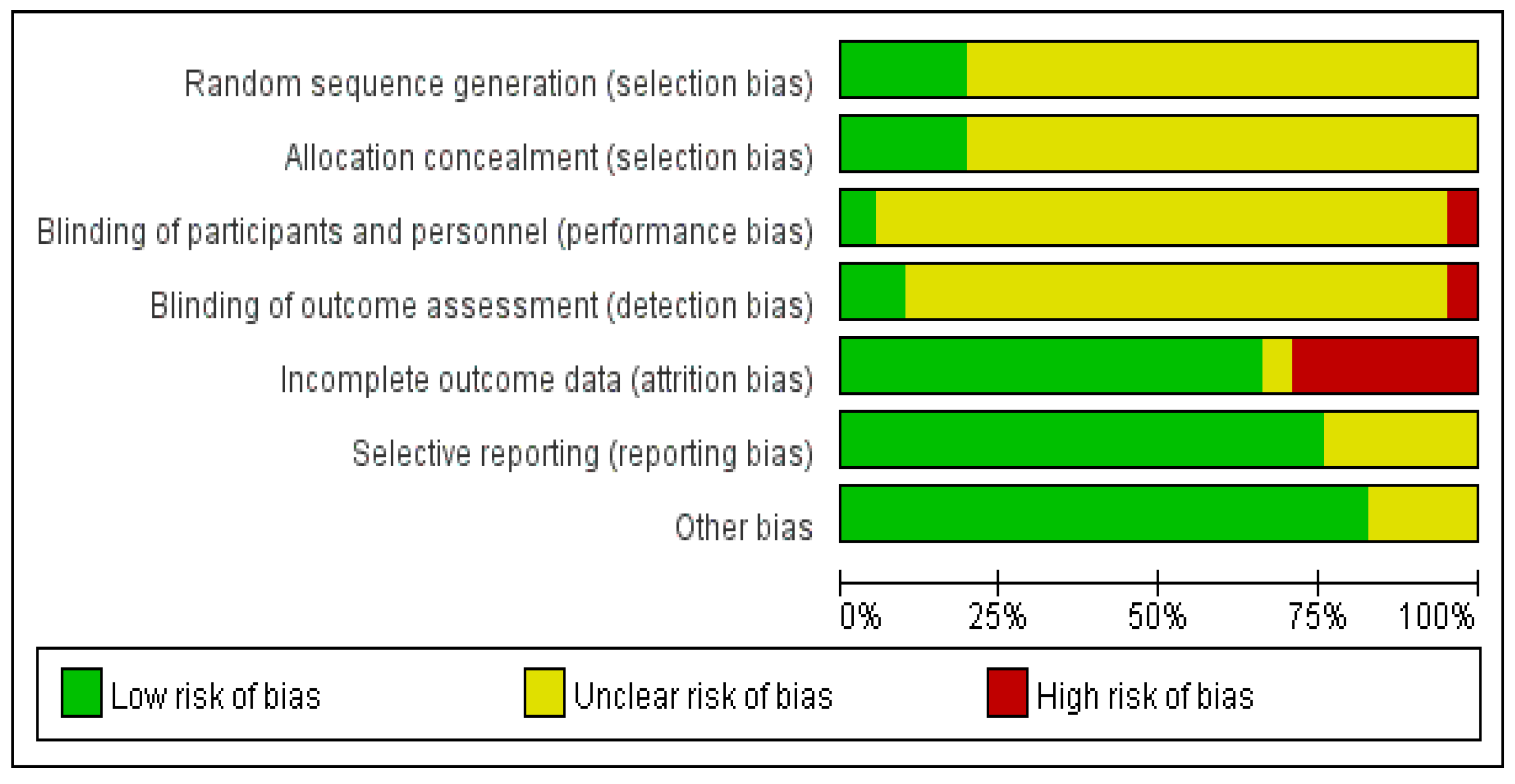
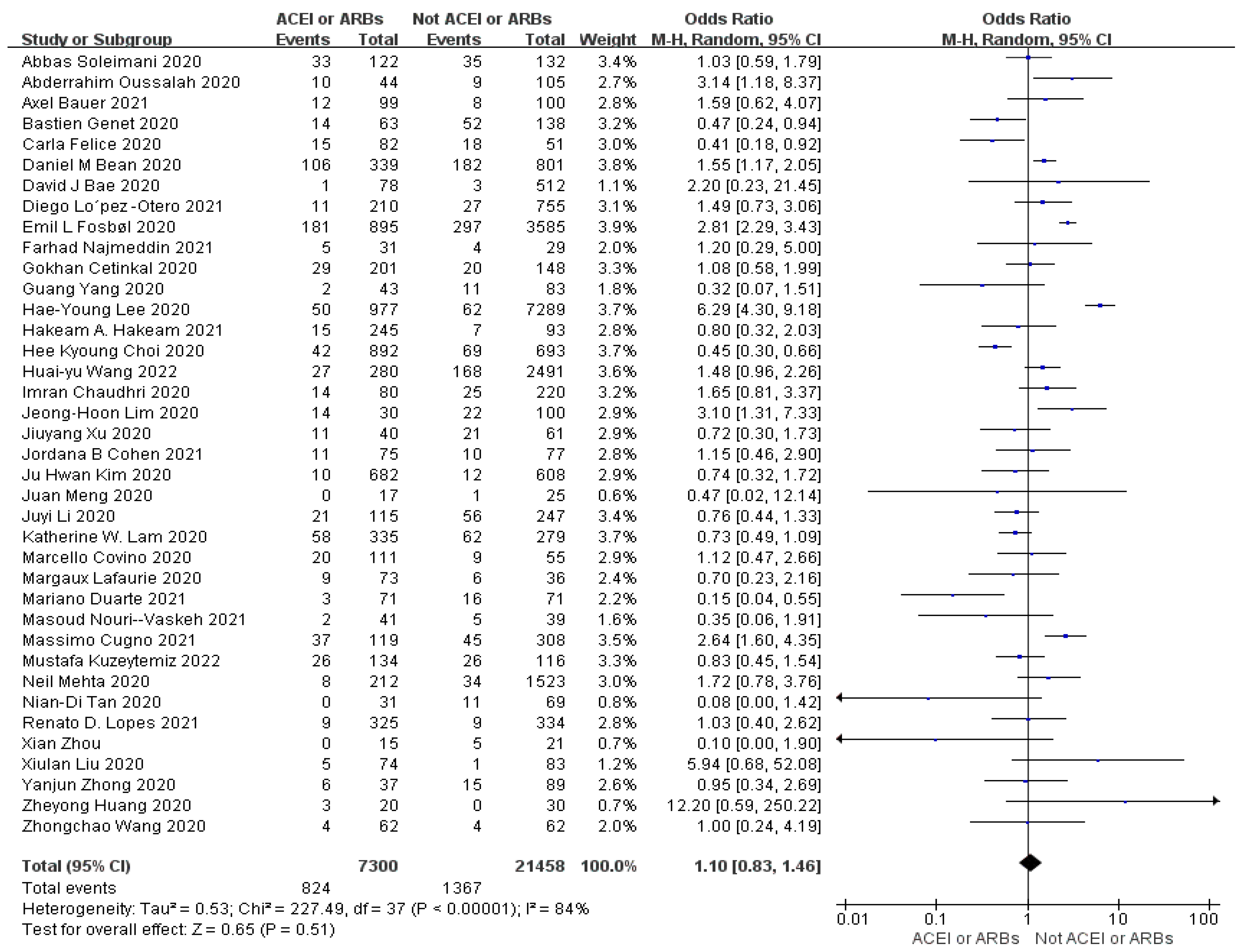
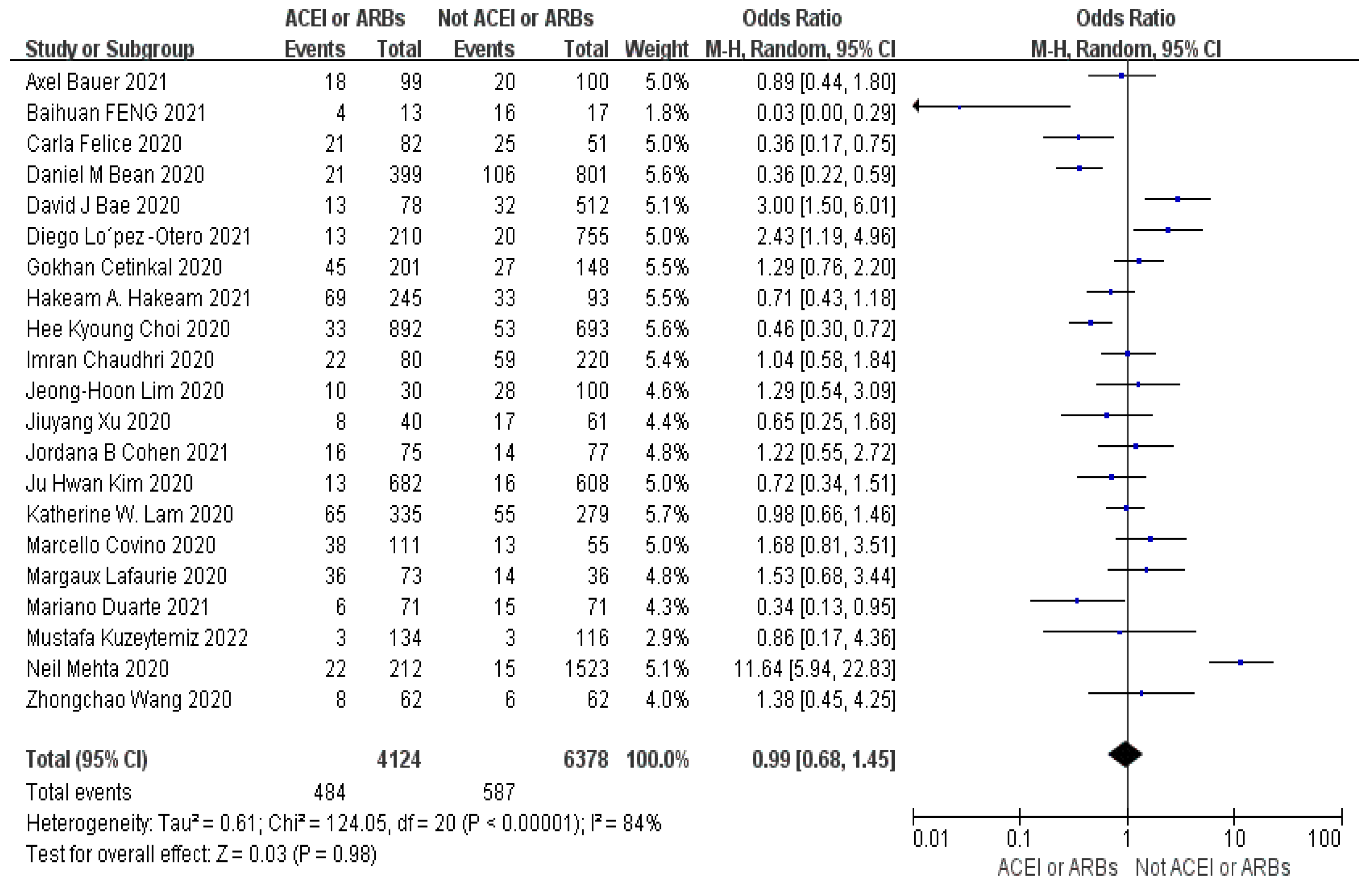
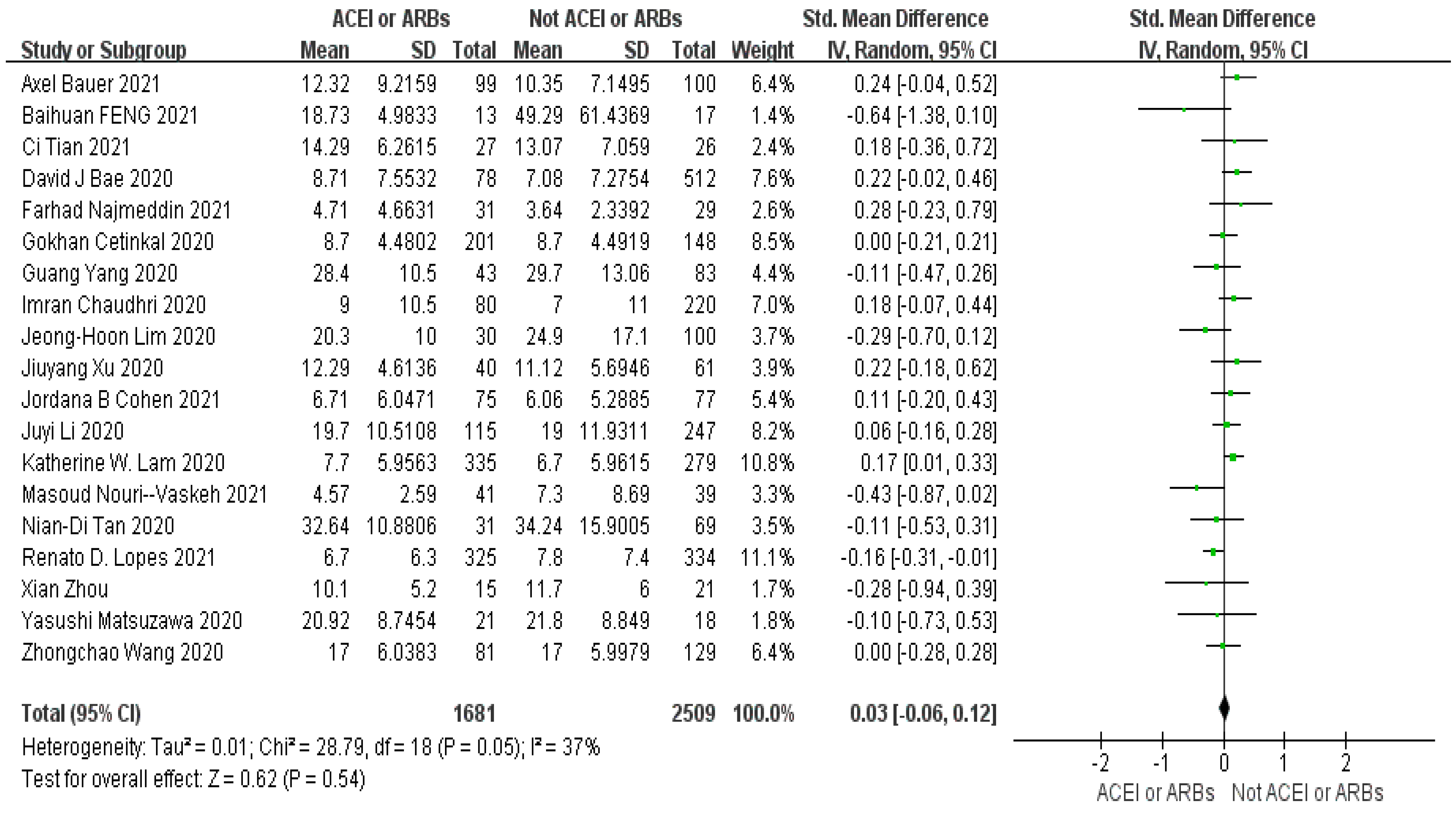
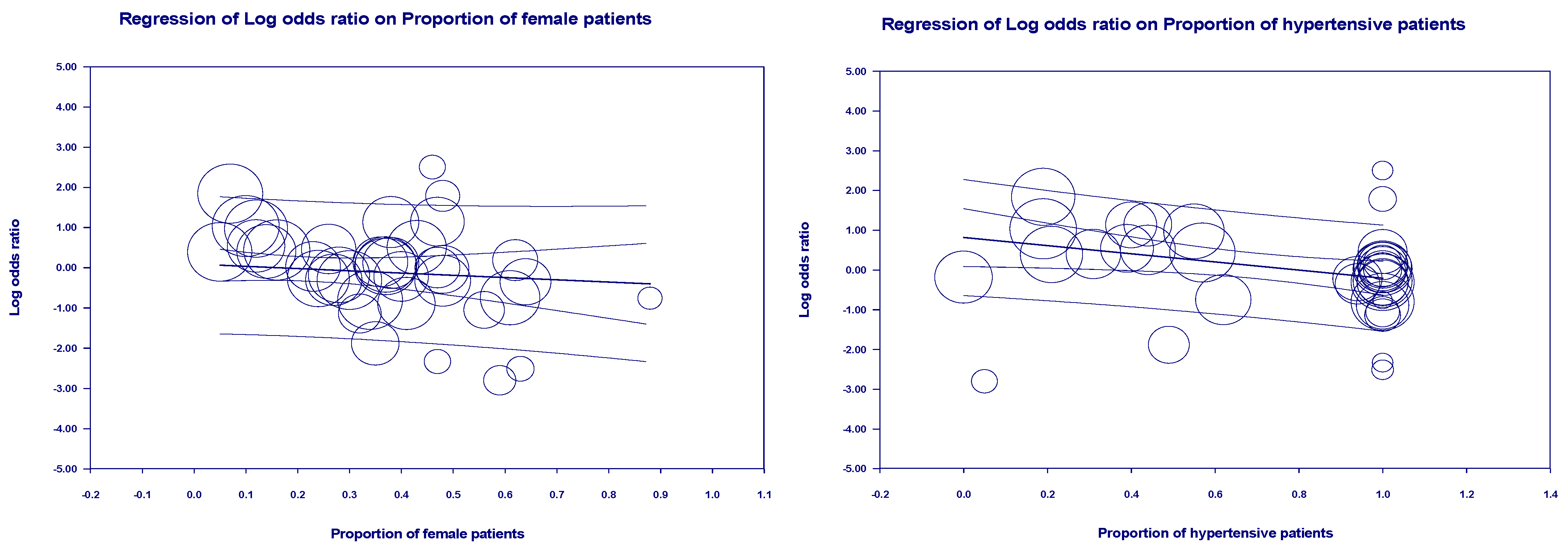

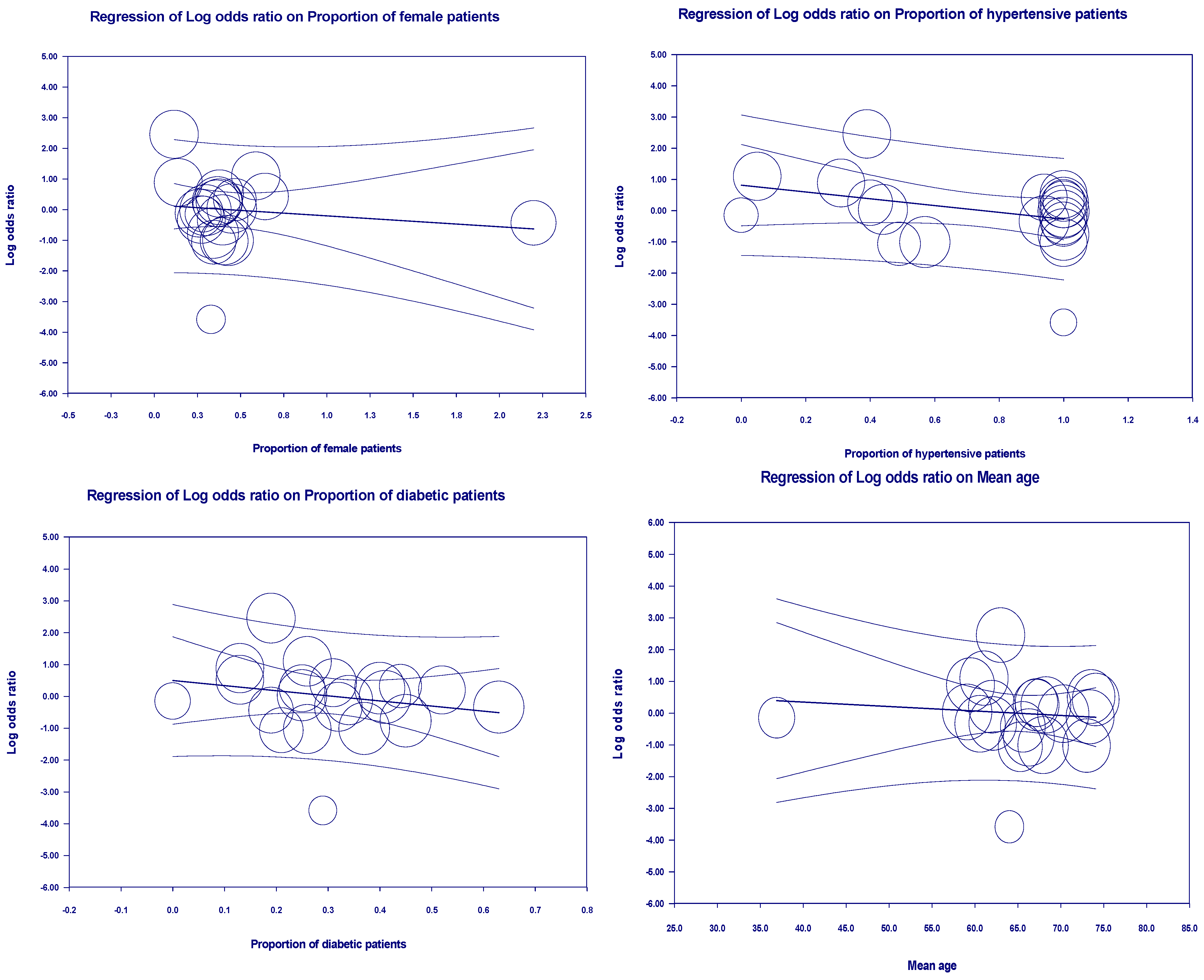
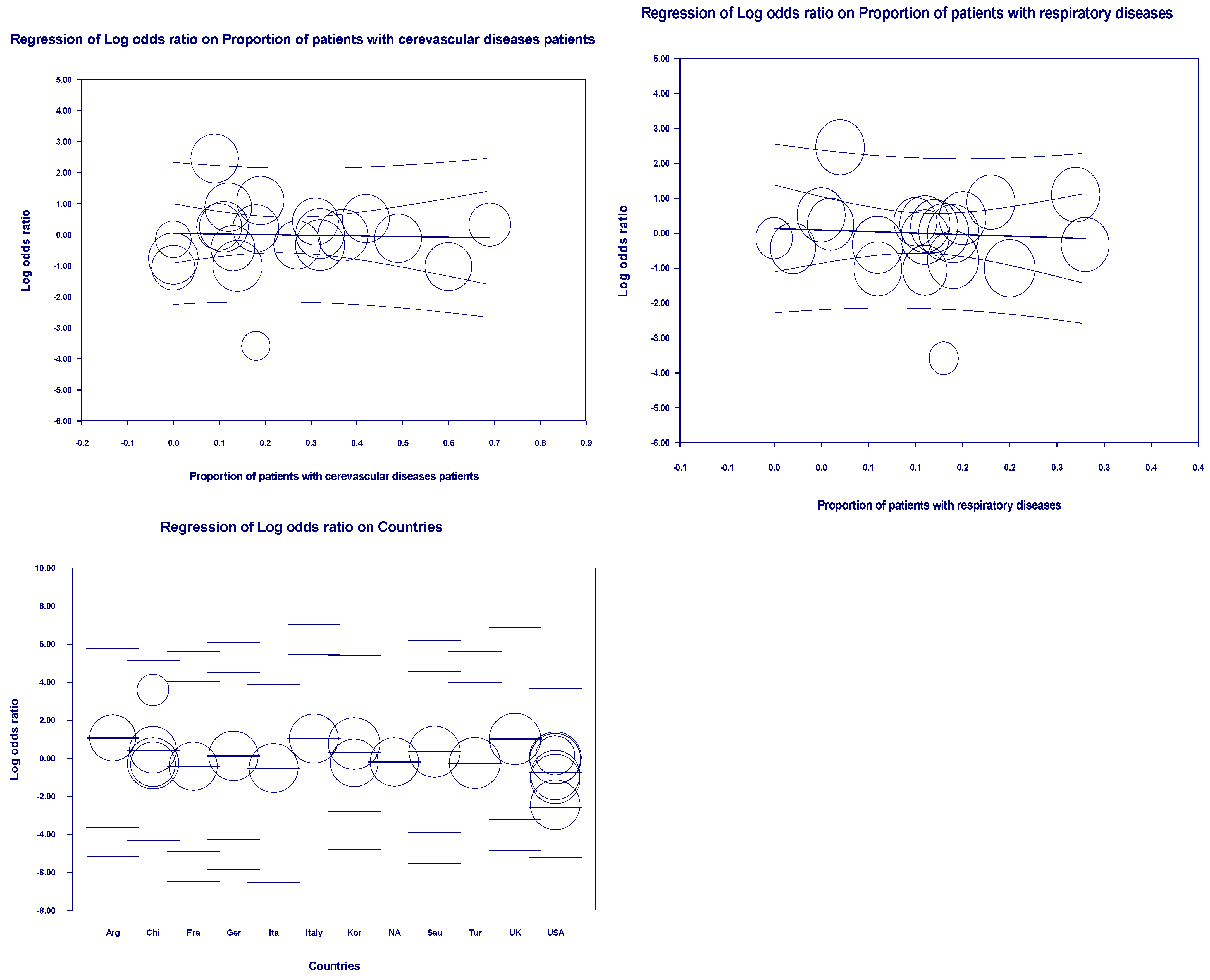

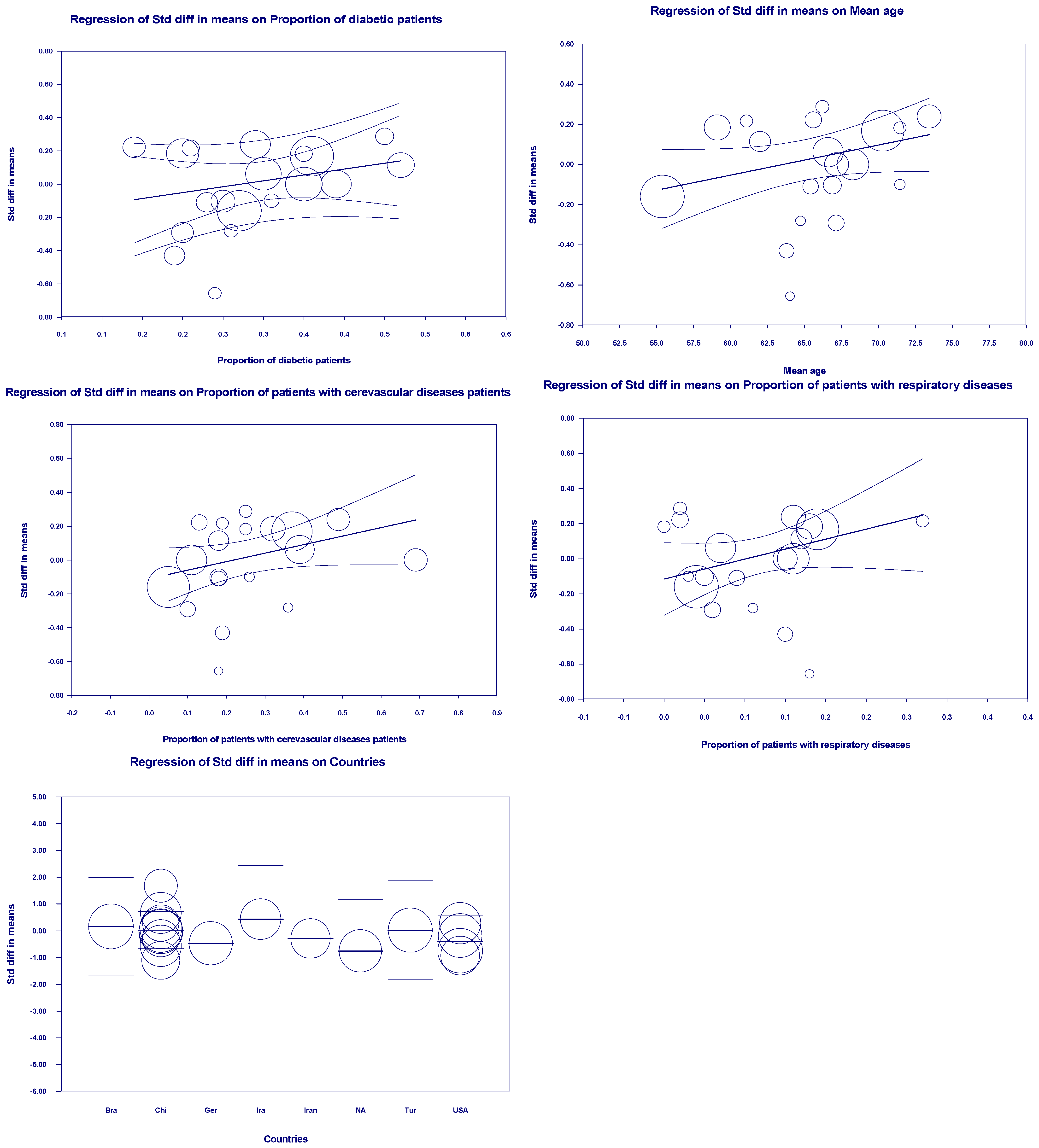
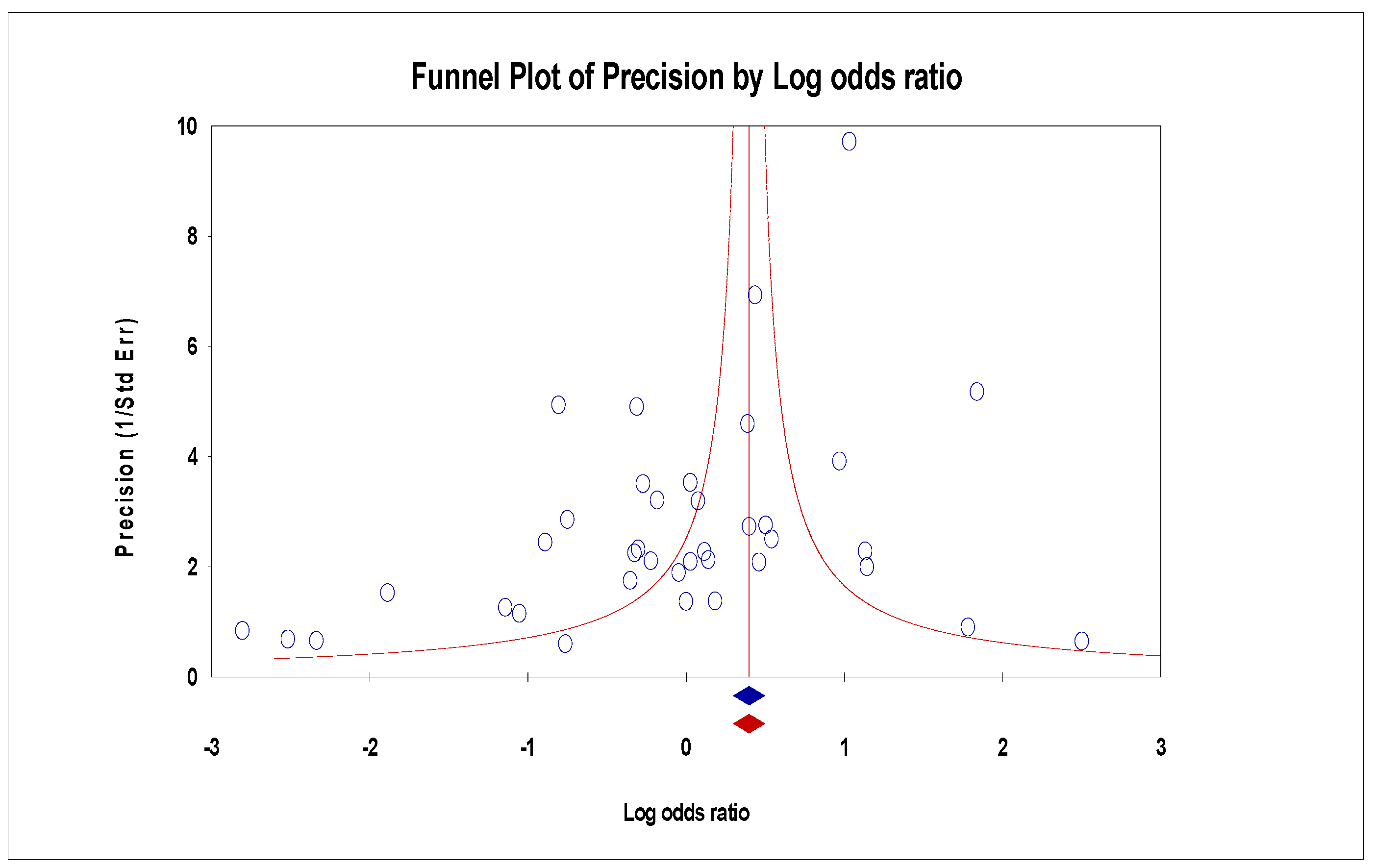

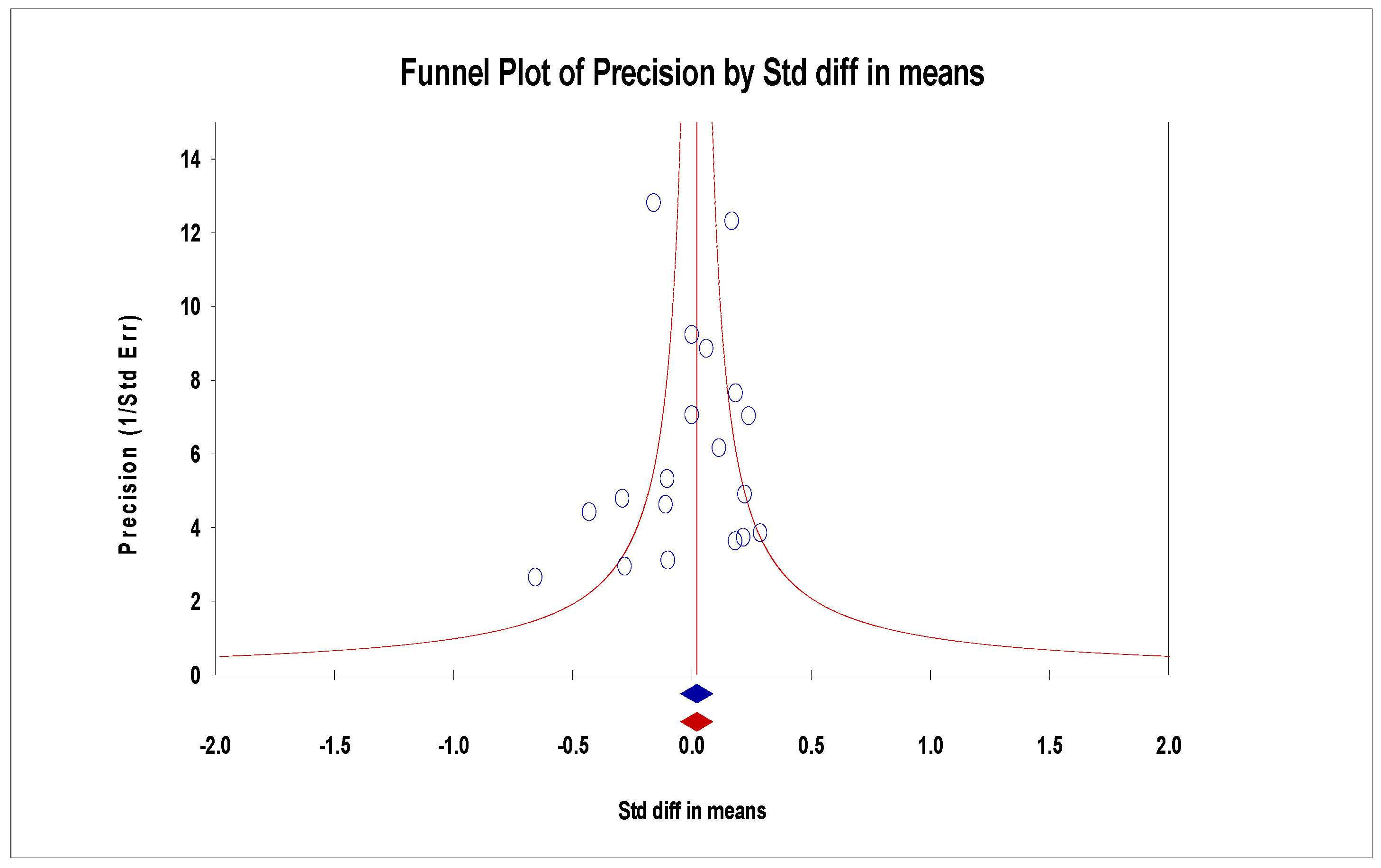
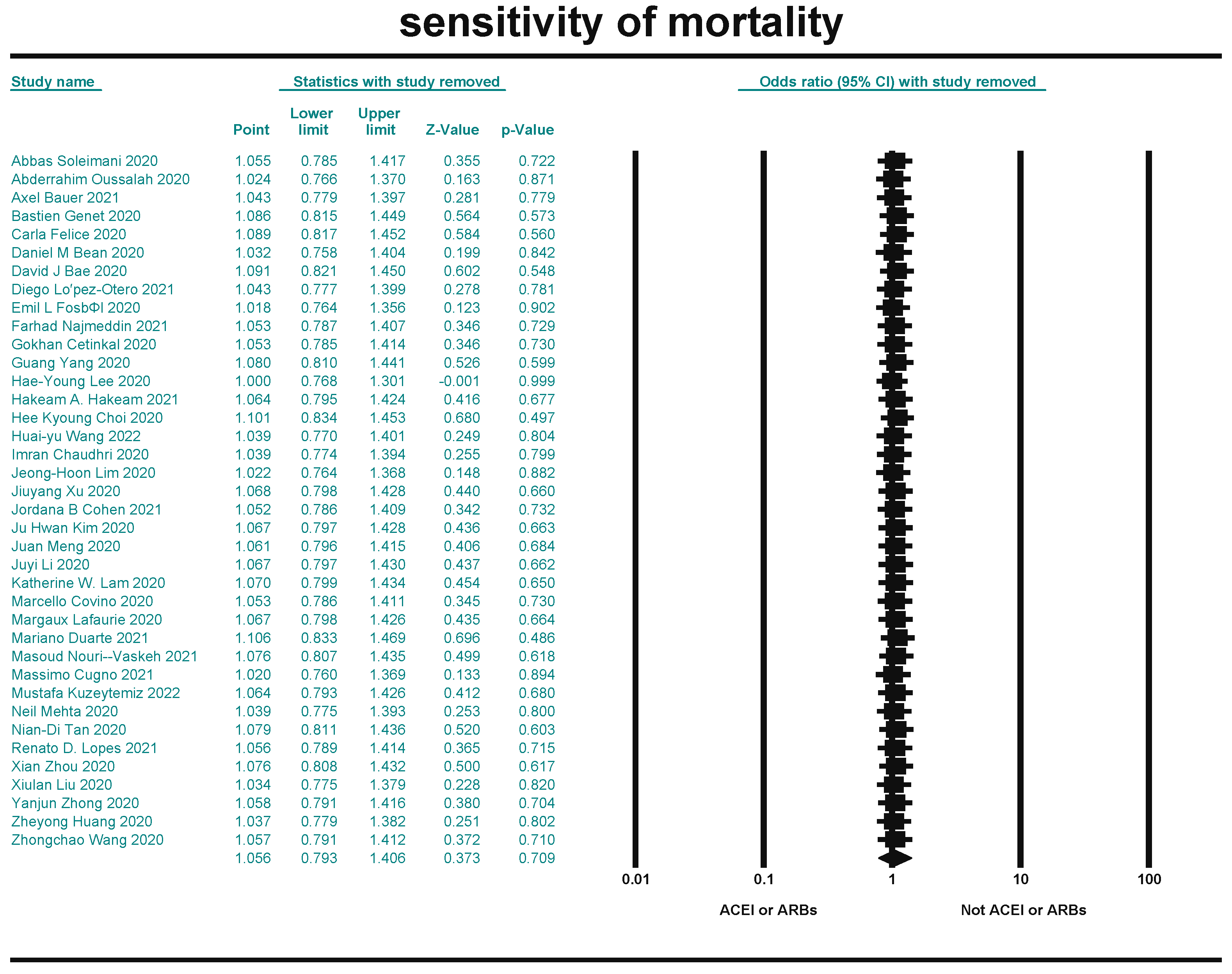

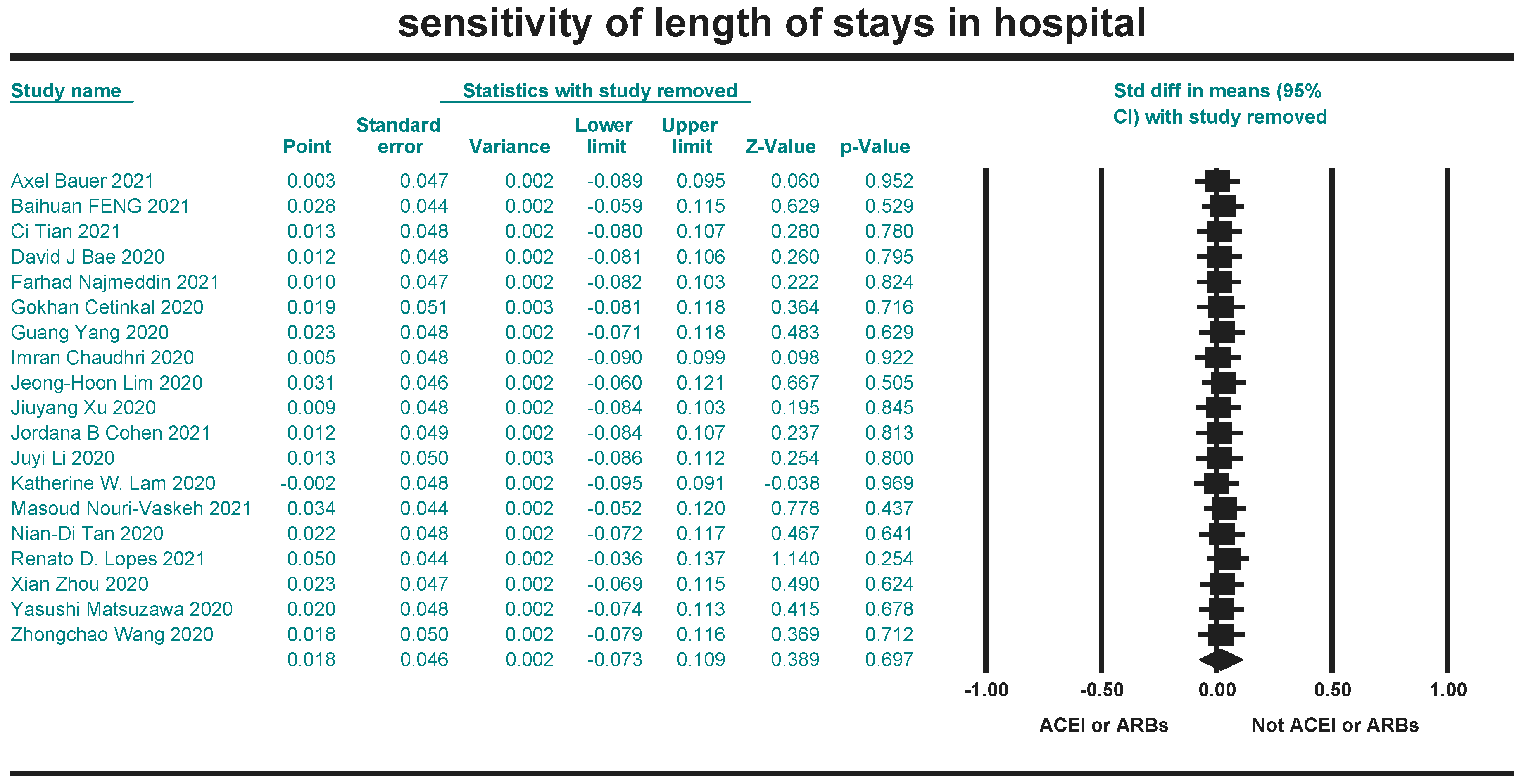
| First Author | Countries | Yp | Mean Age | Pf | Ph | Pd | Pc | Pr | Control Group | Experimental Group | ||||||
|---|---|---|---|---|---|---|---|---|---|---|---|---|---|---|---|---|
| No. | Cm | Cl, Mean, d | Ci | No. | Em | El, Mean, d | Ei | |||||||||
| Abbas Soleimani | Iran | 2020 | 66.39 | 0.37 | 1.00 | 0.00 | 0.43 | 0.09 | 132 | 35 | NA | NA | 122 | 33 | NA | NA |
| Abderrahim Oussalah | France | 2020 | 65.34 | 0.47 | 0.44 | 0.26 | 0.50 | 0.10 | 105 | 9 | NA | NA | 44 | 10 | NA | NA |
| Axel Bauer | Austria and Germany | 2021 | 73.44 | 0.26 | 1.00 | 0.34 | 0.49 | 0.16 | 100 | 8 | 10.35 | 20 | 99 | 12 | 12.32 | 18 |
| Baihuan FENG | China | 2021 | 64.03 | 0.33 | 1.00 | 0.29 | 0.18 | 0.18 | 17 | NA | 49.29 | NA | 13 | NA | 18.73 | NA |
| Bastien Genet | France | 2020 | 86.28 | 0.61 | 0.62 | 0.19 | 0.58 | 0.15 | 138 | 52 | NA | NA | 63 | 14 | NA | NA |
| Carla Felice | Italy | 2020 | 73.02 | 0.41 | 1.00 | 0.26 | 0.60 | 0.11 | 51 | 18 | NA | 25 | 82 | 15 | NA | 21 |
| Ci Tian | China | 2021 | 71.46 | 0.51 | 1.00 | 0.40 | 0.25 | 0.00 | 27 | NA | 13.07 | 15 | 27 | NA | 14.29 | NA |
| Daniel M Bean | UK | 2020 | 67.97 | 0.16 | 0.57 | 0.37 | 0.14 | 0.25 | 801 | 182 | NA | 106 | 399 | 106 | NA | 21 |
| David J Bae | USA | 2020 | 45.98 | 0.59 | 0.05 | 0.26 | 0.19 | 0.32 | 512 | 3 | 7.08 | 13 | 78 | 1 | 8.71 | 7.2 |
| Diego Lo’pez-Otero | Spain | 2021 | 59.50 | 0.14 | 0.31 | 0.13 | 0.12 | 0.23 | 755 | 27 | NA | 20 | 210 | 11 | NA | 13 |
| Emil L Fosbøl | Denmark | 2020 | 40.52 | 0.10 | 0.19 | 0.09 | 0.20 | 0.14 | 3585 | 297 | NA | NA | 895 | 181 | NA | NA |
| Farhad Najmeddin | Iran | 2021 | 66.21 | 0.62 | 1.00 | 0.50 | 0.25 | 0.02 | 29 | 4 | 3.64 | NA | 31 | 5 | 4.71 | 4 |
| Gokhan Cetinkal | Turkey | 2020 | 68.28 | 0.37 | 1.00 | 0.40 | 0.11 | 0.16 | 148 | 20 | 8.70 | 27 | 201 | 29 | 8.70 | 45 |
| Guang Yang | China | 2020 | 66.90 | 0.32 | 1.00 | 0.30 | 0.18 | 0.05 | 83 | 11 | 29.70 | NA | 43 | 2 | 28.40 | NA |
| Hae-Young Lee | Republic of Korea | 2020 | 44.40 | 0.07 | 0.19 | 0.17 | 0.07 | 0.14 | 7289 | 62 | NA | NA | 977 | 50 | NA | NA |
| Hakeam A. Hakeam | Saudi Arabia | 2021 | 60.61 | 0.40 | 0.94 | 0.63 | 0.32 | 0.11 | 93 | 7 | NA | 33 | 245 | 15 | NA | 69 |
| Hee Kyoung Choi | Republic of Korea | 2020 | 66.31 | 0.34 | 1.00 | 0.45 | 0.00 | 0.19 | 693 | 69 | NA | 53 | 892 | 42 | NA | 33 |
| Huai-yu Wang | China | 2022 | 65.00 | 0.05 | 0.21 | 0.11 | 0.05 | 0.02 | 2491 | 168 | NA | NA | 280 | 27 | NA | NA |
| Imran Chaudhri | USA | 2020 | 59.11 | 0.43 | 0.44 | 0.25 | 0.32 | 0.18 | 220 | 25 | 7.00 | 59 | 80 | 14 | 9.00 | 22 |
| Jeong-Hoon Lim | Republic of Korea | 2020 | 67.14 | 0.38 | 0.40 | 0.25 | 0.10 | 0.06 | 100 | 22 | 24.90 | 28 | 30 | 14 | 20.30 | 10 |
| Jiuyang Xu | China | 2020 | 65.60 | 0.48 | 1.00 | 0.19 | 0.13 | 0.02 | 61 | 21 | 11.12 | 17 | 40 | 11 | 12.29 | 8 |
| Jordana B Cohen | 7 countries | 2021 | 62.00 | 0.36 | 1.00 | 0.52 | 0.18 | 0.17 | 77 | 10 | 6.06 | 14 | 75 | 11 | 6.71 | 16 |
| Ju Hwan Kim | Republic of Korea | 2020 | 62.09 | 0.27 | 1.00 | 0.32 | 0.27 | 0.33 | 608 | 12 | NA | 16 | 682 | 10 | NA | 13 |
| Juan Meng | China | 2020 | 64.30 | 0.88 | 1.00 | 0.10 | 0.19 | 0.00 | 25 | 1 | NA | NA | 17 | 0 | NA | NA |
| Juyi Li | China | 2020 | 66.60 | 0.24 | 1.00 | 0.35 | 0.39 | 0.07 | 247 | 56 | 19.00 | 56 | 115 | 21 | 19.70 | NA |
| Katherine W. Lam | USA | 2020 | 70.30 | 0.30 | 1.00 | 0.41 | 0.37 | 0.19 | 279 | 62 | 6.70 | 55 | 335 | 58 | 7.70 | 65 |
| Marcello Covino | Italy | 2020 | 73.55 | 0.38 | 1.00 | 0.13 | 0.42 | 0.05 | 55 | 9 | NA | 13 | 111 | 20 | NA | 38 |
| Margaux Lafaurie | France | 2020 | 74.09 | 0.64 | 0.94 | 0.31 | 0.31 | 0.20 | 36 | 6 | NA | 14 | 73 | 9 | NA | 36 |
| Mariano Duarte | Argentina | 2021 | 65.30 | 0.35 | 0.49 | 0.21 | 0.00 | 0.16 | 71 | 16 | 15.00 | 15 | 71 | 3 | 9.00 | 6 |
| Masoud Nouri-Vaskeh | Iran | 2021 | 63.79 | 0.56 | 1.00 | 0.24 | 0.19 | 0.15 | 39 | 5 | 7.30 | NA | 41 | 2 | 4.57 | NA |
| Massimo Cugno | Italy | 2021 | 60.70 | 0.12 | 0.55 | 0.17 | 0.11 | 0.00 | 308 | 45 | NA | NA | 119 | 37 | NA | NA |
| Mustafa Kuzeytemiz | USA | 2022 | 36.92 | 0.28 | 0.00 | 0.00 | 0.00 | 0.00 | 116 | 26 | NA | 3 | 134 | 26 | NA | 3 |
| Neil Mehta | USA | 2020 | 63.00 | 0.12 | 0.39 | 0.19 | 0.09 | 0.07 | 1523 | 34 | NA | 15 | 212 | 8 | NA | 22 |
| Nian-Di Tan | China | 2020 | 65.42 | 0.63 | 1.00 | 0.28 | 0.18 | 0.09 | 69 | 11 | 34.24 | NA | 31 | 0 | 32.64 | NA |
| Renato D. Lopes | Brazil | 2021 | 55.39 | 0.23 | 1.00 | 0.32 | 0.05 | 0.04 | 334 | 9 | 7.80 | NA | 325 | 9 | 6.70 | NA |
| Xian Zhou | China | 2020 | 64.74 | 0.47 | 1.00 | 0.31 | 0.36 | 0.11 | 21 | 5 | 11.70 | NA | 15 | 2 | 10.10 | NA |
| Xiulan Liu | China | 2020 | 66.39 | 0.48 | 1.00 | 0.27 | 0.10 | 0.00 | 83 | 1 | NA | NA | 74 | 5 | NA | NA |
| Yanjun Zhong | China | 2020 | 66.31 | 0.48 | 1.00 | 0.33 | 0.25 | 0.06 | 89 | 15 | NA | NA | 37 | 6 | NA | NA |
| Yasushi Matsuzawa | Japan | 2020 | 60 | 0.40 | 1.00 | 0.167 | 0.06 | 0.00 | 18 | NA | 21.80 | NA | 21 | NA | 20.92 | NA |
| Zheyong Huang | China | 2020 | 57.90 | 0.46 | 1.00 | 0.08 | 0.04 | 0.02 | 30 | 0 | NA | NA | 20 | 3 | NA | NA |
| Zhongchao Wang | China | 2020 | 67.18 | 0.47 | 1.00 | 0.44 | 0.69 | 0.15 | 62 | NA | 17.00 | 6 | 62 | 4 | 17.00 | 8 |
Disclaimer/Publisher’s Note: The statements, opinions and data contained in all publications are solely those of the individual author(s) and contributor(s) and not of MDPI and/or the editor(s). MDPI and/or the editor(s) disclaim responsibility for any injury to people or property resulting from any ideas, methods, instructions or products referred to in the content. |
© 2025 by the authors. Published by MDPI on behalf of the Polish Respiratory Society. Licensee MDPI, Basel, Switzerland. This article is an open access article distributed under the terms and conditions of the Creative Commons Attribution (CC BY) license (https://creativecommons.org/licenses/by/4.0/).
Share and Cite
Li, R.; Zhang, J.; Ren, L. A Meta-Analysis of the Impact of Using Angiotensin-Converting Enzyme Inhibitors (ACEIs) or Angiotensin II Receptor Blockers (ARBs) on Mortality, Severity, and Healthcare Resource Utilization in Patients with COVID-19. Adv. Respir. Med. 2025, 93, 4. https://doi.org/10.3390/arm93010004
Li R, Zhang J, Ren L. A Meta-Analysis of the Impact of Using Angiotensin-Converting Enzyme Inhibitors (ACEIs) or Angiotensin II Receptor Blockers (ARBs) on Mortality, Severity, and Healthcare Resource Utilization in Patients with COVID-19. Advances in Respiratory Medicine. 2025; 93(1):4. https://doi.org/10.3390/arm93010004
Chicago/Turabian StyleLi, Ruijuan, Jie Zhang, and Liang Ren. 2025. "A Meta-Analysis of the Impact of Using Angiotensin-Converting Enzyme Inhibitors (ACEIs) or Angiotensin II Receptor Blockers (ARBs) on Mortality, Severity, and Healthcare Resource Utilization in Patients with COVID-19" Advances in Respiratory Medicine 93, no. 1: 4. https://doi.org/10.3390/arm93010004
APA StyleLi, R., Zhang, J., & Ren, L. (2025). A Meta-Analysis of the Impact of Using Angiotensin-Converting Enzyme Inhibitors (ACEIs) or Angiotensin II Receptor Blockers (ARBs) on Mortality, Severity, and Healthcare Resource Utilization in Patients with COVID-19. Advances in Respiratory Medicine, 93(1), 4. https://doi.org/10.3390/arm93010004




